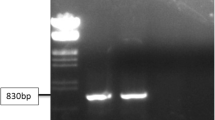Abstract
Apple chlorotic leaf spot virus (ACLSV) seems to be the causal agent of apricot viruela disease. This disease has become an important problem for apricot production in Spain, mainly affecting the ‘Búlida’ cultivar, although no information is available about the behaviour of other cultivars with regards to ACLSV. In this study, the behaviour of 29 apricot cultivars against ACLSV (Apr 62 isolate) was evaluated under controlled conditions in an insect-proof greenhouse. Three different rootstocks, ‘GF305’ peach, ‘Real Fino’ apricot and ‘Adesoto’ plum, were first inoculated by grafting ACLSV-infected bark and were later grafted with the apricot cultivar to be evaluated. Apricot cultivars were evaluated during three cycles of study. ACLSV was asymptomatic on the leaves of all cultivars and rootstocks, so level of susceptibility or resistance was determined by virus detection through RT-PCR. ‘GF305’ rootstock showed a greater susceptibility level than ‘Real Fino’ and ‘Adesoto’. Most of the cultivars were susceptible to ACLSV with different levels of susceptibility, and only ‘Bergeron’ and ‘Mauricio’ were resistant.

Similar content being viewed by others
References
Al Rwahnih, M., Turturo, C., Minafra, A., Saldarelli, P., Myrta, A., Pallás, V., et al. (2004). Molecular variability of Apple chlorotic leaf spot virus in different host and geographical regions. Journal of Plant Pathology, 86, 117–122.
Alioto, D., Stavolone, L., & Ragozzino, A. (1995). Deformation and discoloration of apricot fruits. Acta Horticulturae, 386, 118–121.
Bernhard, R., Marénaud, C., & Sutic, D. (1969). Le pêcher GF305 indicateur polyvalent des virus des espèces a noyau. Annals of Phytopathology, 1, 603–617.
Cambra, M., Llácer, G., Aramburu, J., & Laviña, A. (1986). Translocation of Chlorotic leaf spot virus and Prunus necrotic ring spot viruses in apricot and peach seedlings. Acta Horticulturae, 193, 95–99.
Cañizares, M. C., Aparicio, F., Amari, K., & Pallás, V. (2001). Studies on the etiology of apricot viruela disease. Acta Horticulturae, 550, 249–255.
Carstens, E. B. (2010). Ratification vote on taxonomic proposals to the International Committee on Taxonomy of Viruses (2009). Archives of Virology, 155, 133–146.
Desvignes, J. C., & Boyé, R. (1988). Different disease caused by the Chlorotic leaf spot virus on the fruit trees. Acta Horticulturae, 235, 31–35.
Dosba, F., Lansac, M., Gall, H., & Huguet, J. G. (1986). Incidence of Apple chlorotic leaf spot virus (CLSV) and Prunus necrotic ring spot virus (NRSV) on apricot cv. Canino grafted on two different seedling rootstocks. Acta Horticulturae, 193, 101–106.
Dunez, J., Delbos, R., & Bertranet, R. (1973). Le rôle de différents facteurs de stabilisation appliqués à la purification du virus du Chlorotic Leaf spot. Annals of Phytopathology, 5, 255–265.
García-Ibarra, A. (2011). Incidencia, transmisión y resistencia a Apple Chlorotic Leaf Spot Virus (ACLSV) en albaricoquero (Prunus armeniaca L.). Dissertation, Polytechnic University of Cartagena, Murcia (Spain).
García-Ibarra, A., Rubio, M., Sánchez-Navarro, J. A., Soler, A., Dicenta, F., & Martínez-Gómez, P. (2010a). Study on the etiology of the apricot “viruela” disease in the Region of Murcia (Spain). Acta Horticulturae, 862, 491–494.
García-Ibarra, A., Rubio, M., Dicenta, F., & Martínez-Gómez, P. (2010b). Evaluation of resistance to Apple Chlorotic Leaf Spot Virus (ACLSV) in controlled greenhouse conditions in the apricot breeding programme of CEBAS-CSIC in Murcia (Spain). Acta Horticulturae, 862, 487–490.
García-Ibarra, A., Clemente, M. J., Barba-Espín, G., Díaz-Vivancos, P., Rubio, M., Dicenta, F., et al. (2011). Changes in the antioxidative metabolism induced by Apple chlorotic leaf spot virus infection in peach (Prunus persica Batsch). Environmental and Experimental Botany, 70, 277–282.
Llácer, G. (1973). Resultados de una encuesta sobre la viruela del albaricoquero en la zona de Murcia. V International Symposium on Apricot Culture and Decline, 1, 223–229.
Mañas, F., López, P., & Rodríguez, A. (2000). Caracterización y mejora del material vegetal del albaricoque Moniquí de la comarca de Hellín. Memoria ITAP 2000
Martelli, G. P., Candresse, T., & Namba, S. (1994). Trichovirus, a new genus of plant viruses. Archives of Virology, 134, 451–455.
Peña-Iglesias, A. (1968). Investigaciones sobre la viruela del albaricoquero, probable virosis de este frutal. Boletín de Patología Vegetal y Entomología Agrícola, 30, 325–335.
Peña-Iglesias, A. (1988). Apricot pseudopox (viruela) diseases. Acta Horticulturae, 209, 163–168.
Peña-Iglesias, A., & Ayuso, P. (1970). Recherches sur une probable maladie à virus: La “viruela” de l’abricotier. Annalles de Phytopathologie, 1, 85–94.
Peña-Iglesias, A., & Ayuso, P. (1975). Preliminary identification of the viruses producing Spanish apricot pseudopox (viruela) and apricot mosaic diseases. Acta Horticulturae, 44, 255–265.
Rubio, M., Martínez-Gómez, P., Pinochet, J., & Dicenta, F. (2005). Evaluation of resistance to sharka (Plum pox virus) of several Prunus rootstocks. Plant Breeding, 124, 67–70.
Rubio, M., García-Ibarra, A., Martínez-Gómez, P., & Dicenta, F. (2009). Analysis of the main factors involved in the evaluation of Prunus resistance to Plum pox virus (Sharka) in controlled greenhouse conditions. Scientia Horticulturae, 123, 46–50.
Sánchez-Navarro, J. A., Aparicio, F., Herranz, M. C., Minafra, A., Myrta, A., & Pallás, V. (2005). Simultaneous detection and identification of eight stone fruit viruses by one-step RT-PCR. European Journal of Plant Pathology, 111, 77–84.
Soler, A., & Cano, A. (2004). Presencia de virosis en albaricoqueros con escasa producción de la Región de Murcia. Región de Murcia: Servicio de Protección y Sanidad Vegetal. 55 pp.
Yanase, H. (1974). Studies on apple latent viruses in Japan. Bulletin of Fruit Tree Research Station of Japan, 1, 47–109.
Acknowledgments
This study was supported by a project of the Seneca Foundation of the Region of Murcia (08672/PI/08): “Importance, transmission and resistance sources of the main viruses affecting stone fruits in the Region of Murcia.”
Author information
Authors and Affiliations
Corresponding author
Rights and permissions
About this article
Cite this article
García-Ibarra, A., Dicenta, F., Martínez-Gómez, P. et al. Evaluation of apricot (Prunus armeniaca L.) resistance to Apple chlorotic leaf spot virus in controlled greenhouse conditions. Eur J Plant Pathol 133, 857–863 (2012). https://doi.org/10.1007/s10658-012-0009-2
Accepted:
Published:
Issue Date:
DOI: https://doi.org/10.1007/s10658-012-0009-2




